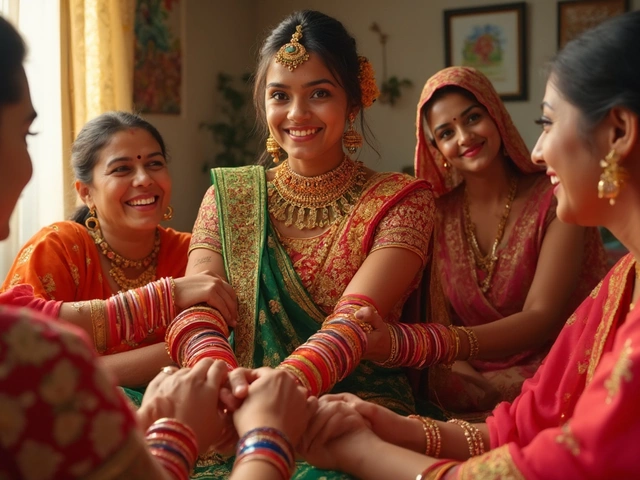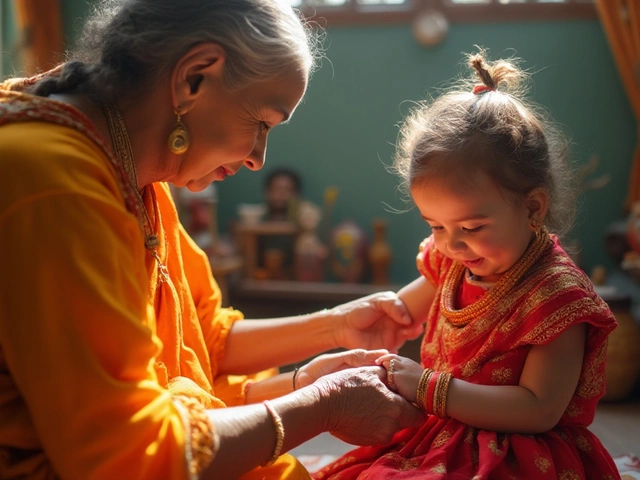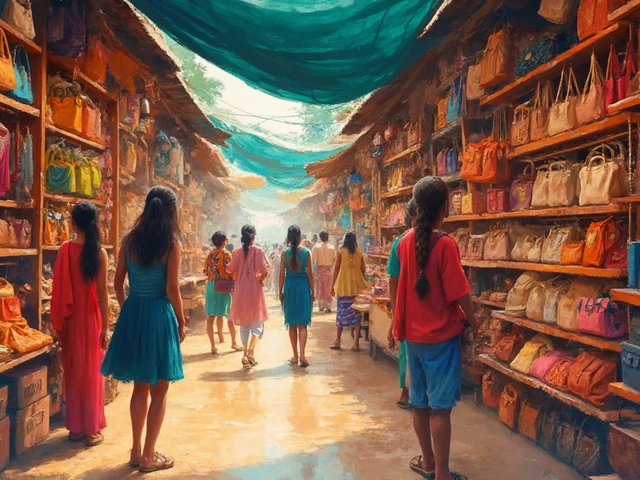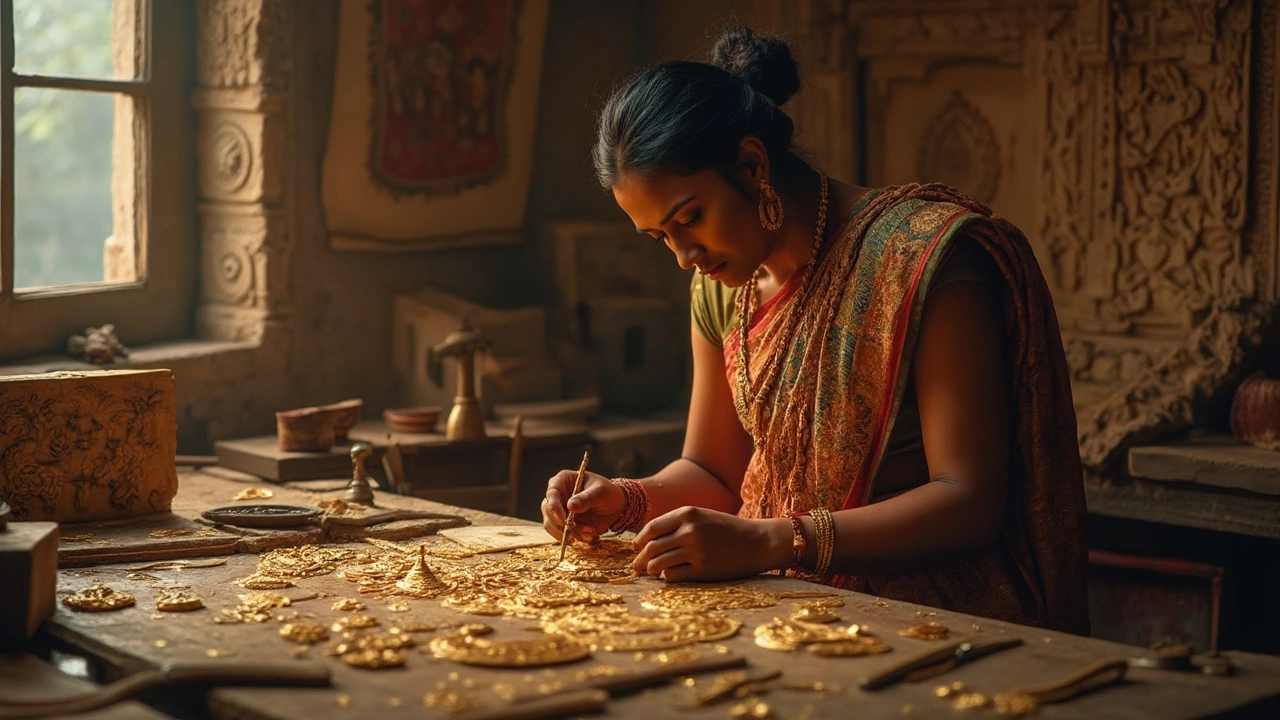
Nakashi jewellery isn’t your average accessory. These pieces have a history that’s as rich as the temples they’re inspired by. What sets Nakashi apart is the heavy dose of intricate, handcrafted details. You won't find mass-produced stuff here—each piece reflects hours of skilled metalwork, all done by hand.
If you’ve ever seen dancers or brides wearing bold gold pieces with distinct carvings, chances are you were looking at Nakashi work. These aren’t just random patterns. Most Nakashi jewellery tells a story, using detailed motifs straight from ancient temple art and Hindu mythology. The craftsmanship makes each item feel like a little wearable sculpture rather than standard bling.
For anyone considering a buy, knowing what sets Nakashi apart can save you from picking up a lookalike. Keep your eyes peeled for unique temple motifs, deep relief work, and that heavy, solid feel—real Nakashi never seems flimsy. Even if you’re just curious about the styles you see during festivals or weddings, it pays to recognize the difference. More on the origins and what to watch for in real Nakashi jewellery comes up next.
- The Origins of Nakashi Jewellery
- How Nakashi Jewellery is Made
- Popular Nakashi Designs and Symbols
- Nakashi Jewellery in Indian Culture
- How to Choose Authentic Nakashi Pieces
- Caring for Your Nakashi Jewellery
The Origins of Nakashi Jewellery
The story of Nakashi jewellery starts deep in South India, especially around Tamil Nadu and Karnataka. These regions have a long connection to temples, where art and ritual blend together. Nakashi work popped up as far back as the 9th century, during the Chola dynasty, when temple culture was a huge deal and so was showing off devotion through what people wore and donated.
This jewellery style pulls directly from the carved sculptures and wall art you see in old temples. Craftsmen literally tried to capture the same level of detail and symbols—with each earring or necklace acting like a tiny piece of temple architecture. Back then, Nakashi pieces weren’t for just anyone—priests, dancers, and royalty were the main folks rocking these heavy gold ornaments.
Here’s something cool—Nakashi work grew out of what’s called the 'repoussé' technique. That means every bit of design gets hammered out from the back of a metal plate to create a raised look on the front. For centuries, this was totally a family trade, with skills handed down through generations.
Till today, Nakashi jewellery carries local themes and old-school techniques, making each piece more than just pretty—it's living history.
| Region | Era of Origin | Common Motifs |
|---|---|---|
| Tamil Nadu | 9th-13th century (Chola period) | Goddesses, temple towers |
| Karnataka | 10th-14th century (Hoysala, Vijayanagara) | Dancing figures, peacocks |
Why does this matter today? Owning or gifting Nakashi jewellery is basically a way to carry a chunk of temple tradition forward. For anyone who’s into Indian heritage, these aren’t just shiny things—they’re part of a bigger story passed down across centuries.
How Nakashi Jewellery is Made
The process behind Nakashi jewellery is hands-on from start to finish. Most Nakashi pieces start with a solid metal base, usually silver or copper. Artisans coat this base with a thick gold layer—which is why Nakashi looks like pure gold, but doesn't break the bank like solid gold jewellery.
What really sets Nakashi apart is the repousse technique. Here’s how it usually goes down:
- The craftsman sketches a design, usually based on temple carvings or mythological figures.
- They hammer the metal from the reverse side, raising those signature relief patterns you see on Nakashi pieces.
- Once the main form pops out, they switch to tiny chisels, adding in fine details and textures on the front.
- Finishing touches include filling any hollows with a paste, making sure the ornament is sturdy but not crazy heavy for the wearer.
- Finally, a coat of 22k or 24k gold is applied to give it that classic, temple-style finish.
If you’re a numbers person, check out how long this actually takes:
| Jewellery Type | Hours of Labor | Artisans Involved |
|---|---|---|
| Small Pendant | 8-12 | 2 |
| Bracelet | 16-24 | 3 |
| Large Necklace | 30+ | 4-5 |
Don’t miss how they use real gemstones, usually rubies, emeralds, or kemp stones, set right into the gold. These gems aren’t just glued in—they’re fixed with sturdy prongs so you won’t lose them at your next dance-off.
These days, a few Nakashi artists are trying out lightweight options, blending traditional skills with comfort. But the real stuff will always feel solid and substantial when you pick it up. Knowing these steps can help you spot the difference if you’re shopping for genuine Nakashi work instead of just something that looks close from a distance.
Popular Nakashi Designs and Symbols
If you take a close look at Nakashi jewellery, you’ll spot patterns and symbols that are not just random bling—they all have a backstory. These designs link straight back to old Indian temples, and you’ll often find them in the best pieces out there.
The most common symbols carved into Nakashi pieces include:
- Nakashi jewellery loves to feature deities—especially Goddess Lakshmi, the symbol of wealth and good luck. You’ll spot her sitting on a lotus or surrounded by elephants.
- Peacocks show up a lot. These birds stand for beauty and power and are a favorite motif, especially in long necklaces and big earrings.
- Floral patterns cover a ton of territory. Lotus flowers are everywhere, symbolizing purity and energy. They get layered on bangles, pendants, and even hair accessories.
- Temple towers (called gopurams) sometimes show up on pendants. It’s a nod to the architecture of real-life temples.
- Other Hindu gods—like Ganesha and Krishna—make appearances too, each wrapped up in detailed storytelling through tiny carvings.
Most Nakashi jewellery uses high-carat gold plating (sometimes sterling silver with gold on top), which gives the pieces a warm, traditional vibe. Stones are usually red and green—think rubies and emeralds, but usually in glass or synthetic versions to keep costs realistic.
| Popular Motif | Meaning | Where You’ll See It |
|---|---|---|
| Goddess Lakshmi | Wealth, luck, blessings | Necklaces, earrings, waist belts |
| Peacock | Beauty, power | Brooches, earrings |
| Lotus | Purity, energy | Bangles, pendants |
| Temple tower (Gopuram) | Divinity, tradition | Pendants, large pendants on necklaces |
| Ganesha/Krishna | Good beginnings, wisdom | Pendants, hair ornaments |
Each design isn’t just for show. The detail and selection of symbols are meant to give blessings, tell a story, or bring good vibes to the person wearing it. If you ever get the chance to look at a Nakashi piece up close, try to spot these stories in its design. It’s like wearing a tiny piece of temple art on your body.
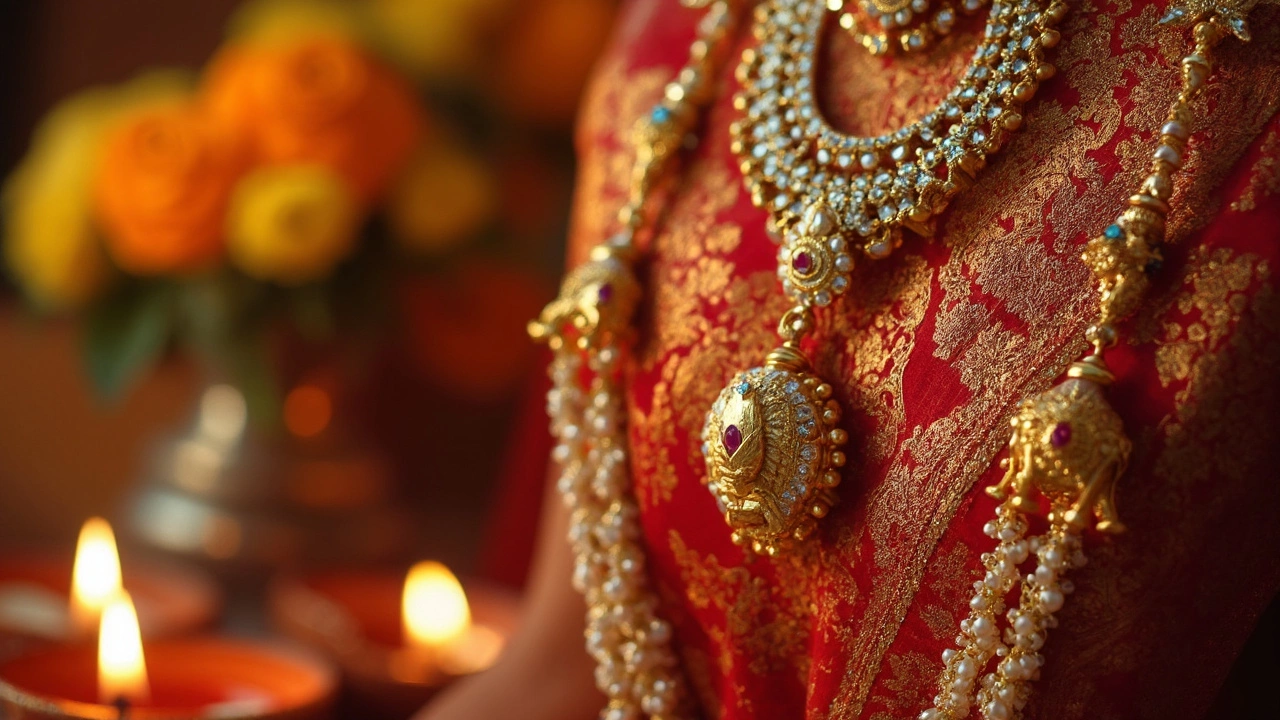
Nakashi Jewellery in Indian Culture
The role of Nakashi jewellery in Indian culture goes way beyond fashion. This type of jewellery has deep roots in temple traditions, especially in South India. People have worn Nakashi pieces for centuries during religious ceremonies, weddings, and even classical dance performances like Bharatanatyam. You’ll usually spot Nakashi jewellery on deities in temples—many old statues are adorned with these detailed ornaments because it’s believed they bring divine blessings.
Nakashi sets are more than pretty—they signal status and devotion. In families with ties to Tamil Nadu or Karnataka, you’ll often find Nakashi passed down through generations as heirlooms. During special festivals like Navratri, women often choose Nakashi pieces to highlight their connection to traditional rituals.
If you’re into stats, here’s a quick look at where Nakashi jewellery pops up most across Indian events and regions:
| Event or Usage | How Often Used |
|---|---|
| Temple Rituals | Very High |
| Bharatanatyam dance | Common |
| South Indian Weddings | High |
| Festivals (e.g., Navratri) | Frequent |
| Family Heirlooms | Common |
There’s something practical here too: picking Nakashi for religious or cultural events can help you fit right in, especially if you’re attending a traditional South Indian wedding or heading to a big temple celebration. Even Bollywood movies love to use Nakashi for period costumes. Spotting these pieces in popular films has made them more recognizable, even for people outside India.
For anyone collecting jewellery, understanding this cultural connection makes every Nakashi piece way more meaningful. These aren’t just ornaments—they’re a living part of India’s temple heritage and family traditions. If you want jewellery with a real story (and some serious craftsmanship), Nakashi is tough to beat.
How to Choose Authentic Nakashi Pieces
Picking real Nakashi jewellery is a bit like finding the perfect street food stall—there are imitations everywhere, but once you know what to look for, spotting the real deal gets easier. If you want to get your hands on genuine Nakashi jewellery, pay attention to these details.
First things first: true Nakashi work is always handcrafted. Each piece shows unique signs of hand-tooling, like slightly irregular lines or super-fine detail you won’t see in cast or machine-made stuff. Mass-produced bits look too perfect and lack depth in their carvings.
- Material matters: Real Nakashi pieces are usually made from high-quality gold or silver. Sometimes, you’ll find copper or alloys for affordable versions, but traditional sets always use precious metals. Check for a hallmark on gold or silver – that’s a legit stamp.
- Intricate carving: Forget about flat surfaces. Authentic Nakashi is all about raised patterns, layers, and delicate borders featuring motifs like peacocks, gods, or floral vines. You’ll often see dreamy South Indian designs straight from temple carvings—no shortcuts here.
- Weight check: Nakashi jewellery feels dense and solid. Even a small pendant or bangle will have some serious weight, since artisan makers never skimp on material. Flimsy or lightweight stuff is a red flag.
- Finish and polish: Genuine Nakashi work sports a matte or antique finish, not blingy high-shine. This gives the motifs a striking look and helps show off the fine handwork.
- Stones and embellishments: Many Nakashi pieces include traditional stones—think rubies, emeralds, white pearls, or uncut gems. Usually, the settings are tight and even, never glued on in a mess.
Don’t rely only on looks. Ask the seller about where the piece was made, and who the artisan is. The best Nakashi usually comes from southern states like Tamil Nadu and Andhra Pradesh. If the vendor hesitates to reveal details, think twice before buying.
Here’s a quick table that compares the features in authentic Nakashi versus generic temple-style jewellery:
| Feature | Authentic Nakashi | Imitation/Groomed Pieces |
|---|---|---|
| Making Process | Handcrafted | Machine-made or cast |
| Material | Gold/Silver, sometimes copper | Alloys or cheap metals |
| Finish | Matte/Antique | High shine or fake antique |
| Details | Fine, deep carving and motifs | Shallow, repetitive patterns |
| Region | Mostly South India | Mass-produced, no fixed region |
One more tip: Buy from trusted dealers or government-certified showrooms, especially if you’re spending big. Some sellers offer a certificate of authenticity or will let you meet the artisan or see their workshop. That kind of transparency almost always points to the real thing.
Spotting real Nakashi isn’t rocket science, just a matter of knowing what makes it special and trusting your eye for detail. Once you’ve handled a genuine piece, it’s tough to settle for anything less.
Caring for Your Nakashi Jewellery
Taking care of Nakashi jewellery isn’t rocket science, but it does need some attention. Since these pieces are handcrafted and carry a lot of traditional value, a little caution goes a long way. Sweat, perfumes, and even moisture can mess with their finish. So, if you want your Nakashi jewellery to last generations, it’s worth building a few habits.
First thing—keep your Nakashi pieces dry. Gold and silver often react with water, especially if you live somewhere humid like Chennai or Mumbai. I always wipe Luna’s fur off my shirt before even touching any jewellery, trust me—stray pet hair can get stuck in all the nooks and crannies.
- Store each item in a separate soft pouch or cloth-lined box. This stops the delicate details from getting scratched or tangled up.
- Take off your jewellery before getting into the shower, swimming, or even while slathering on lotions.
- After each use, wipe your Nakashi pieces with a soft cloth to remove oils, sweat, and dust.
- Keep them away from perfumes, hairsprays, and chemical cleaners. These can tarnish or dull the finish.
If you want to go the extra mile, get a soft-bristled brush to clean carved grooves. Don’t use toothpaste or harsh cleaners—it’s a quick way to ruin the shine. Every few months, a jeweller who understands traditional crafts should check for loose stones or any minor damage. Spotting little issues early always saves money later on.
If you want heritage jewellery to ‘look as stunning as the day it was made, keep it away from chemicals and moisture,’ says Aarthi Ramaswamy, founder of Temple Artisans Collective, who has restored dozens of century-old Nakashi pieces.
Check out this quick rundown to help your Nakashi jewellery stand the test of time:
| Action | Frequency | Benefit |
|---|---|---|
| Wipe with soft cloth | After every use | Removes oils and sweat |
| Deep clean (soft brush) | Monthly | Keeps grooves clean |
| Professional checkup | Twice a year | Finds loose stones, fixes small problems |
| Proper storage | Always | Prevents damage |
With the right care, Nakashi jewellery can stick around for decades, if not longer. You get more than just shine—you get family stories and real value that lasts well beyond trends.
